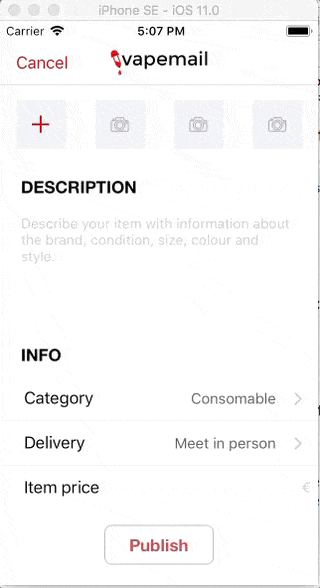我在一个UIViewController的表视图中有一个UITextField(不是UITableViewController)。如果表视图在UITableViewController上,表格将自动滚动到正在编辑的textField,以防止其被键盘遮挡。但是在UIViewController上却没有这样的效果。
我尝试了几天,阅读了多种方式来尝试实现此目标,但我无法让它工作。最接近实际滚动的方法是:
-(void) textFieldDidBeginEditing:(UITextField *)textField {
// SUPPOSEDLY Scroll to the current text field
CGRect textFieldRect = [textField frame];
[self.wordsTableView scrollRectToVisible:textFieldRect animated:YES];
}
然而,这只能将表格滚动到最顶端的行。
看起来简单的任务已经让我沮丧了几天。
我正在使用以下代码来构建tableView的单元格:
- (UITableViewCell *)tableView:(UITableView *)aTableView
cellForRowAtIndexPath:(NSIndexPath *)indexPath {
NSString *identifier = [NSString stringWithFormat: @"%d:%d", [indexPath indexAtPosition: 0], [indexPath indexAtPosition:1]];
UITableViewCell *cell = [aTableView dequeueReusableCellWithIdentifier:identifier];
if (cell == nil) {
cell = [[[UITableViewCell alloc]
initWithStyle:UITableViewCellStyleDefault
reuseIdentifier:identifier] autorelease];
cell.accessoryType = UITableViewCellAccessoryNone;
UITextField *theTextField = [[UITextField alloc] initWithFrame:CGRectMake(180, 10, 130, 25)];
theTextField.adjustsFontSizeToFitWidth = YES;
theTextField.textColor = [UIColor redColor];
theTextField.text = [textFieldArray objectAtIndex:indexPath.row];
theTextField.keyboardType = UIKeyboardTypeDefault;
theTextField.returnKeyType = UIReturnKeyDone;
theTextField.font = [UIFont boldSystemFontOfSize:14];
theTextField.backgroundColor = [UIColor whiteColor];
theTextField.autocorrectionType = UITextAutocorrectionTypeNo;
theTextField.autocapitalizationType = UITextAutocapitalizationTypeNone;
theTextField.clearsOnBeginEditing = NO;
theTextField.textAlignment = UITextAlignmentLeft;
//theTextField.tag = 0;
theTextField.tag=indexPath.row;
theTextField.delegate = self;
theTextField.clearButtonMode = UITextFieldViewModeWhileEditing;
[theTextField setEnabled: YES];
[cell addSubview:theTextField];
[theTextField release];
}
return cell;
}
textFieldDidBeginEditing方法中以某种方式传递indexPath.row,就可以使tableView正确滚动?感激不尽任何帮助。